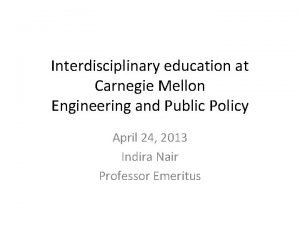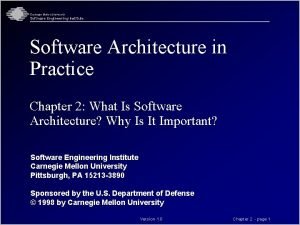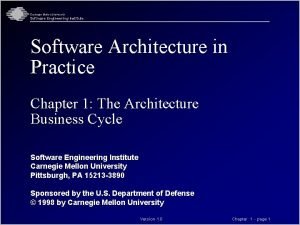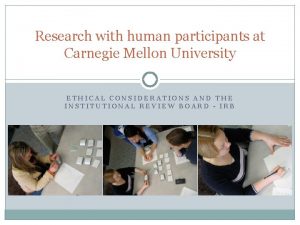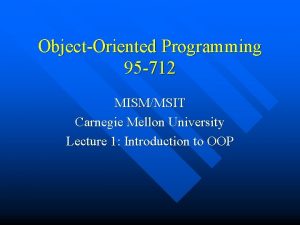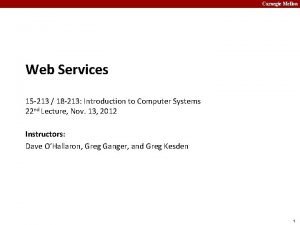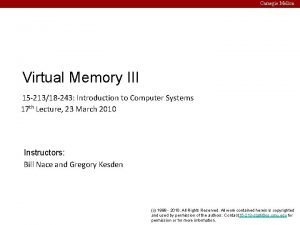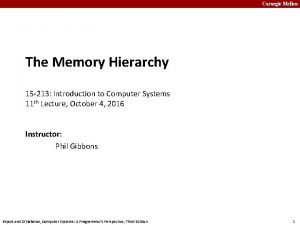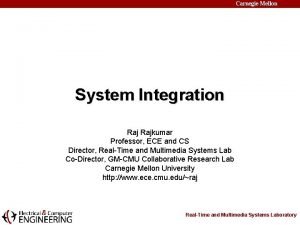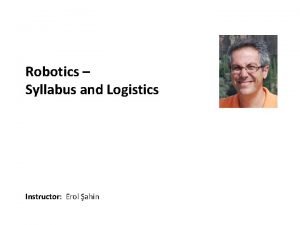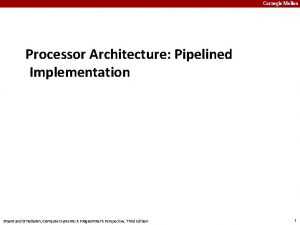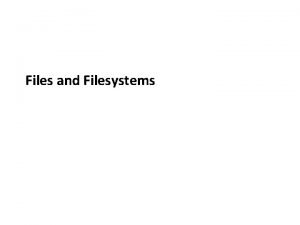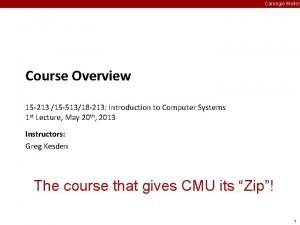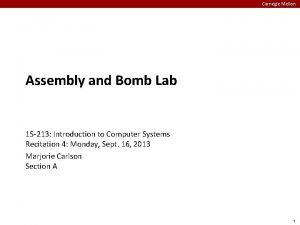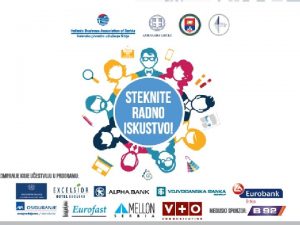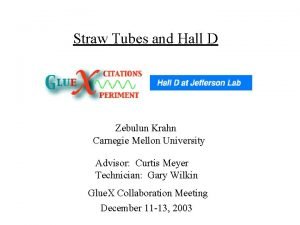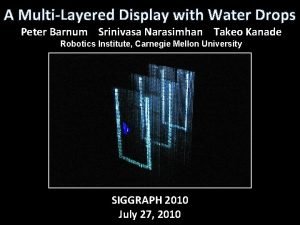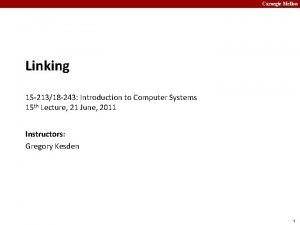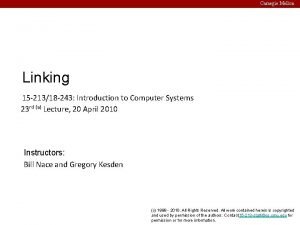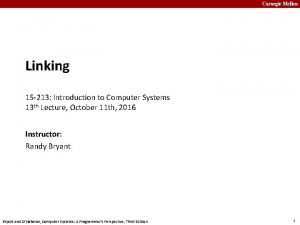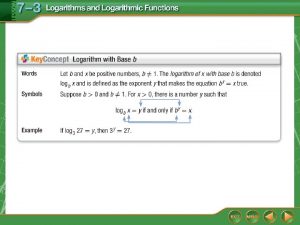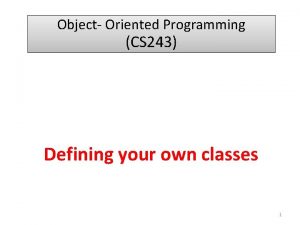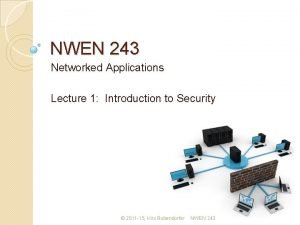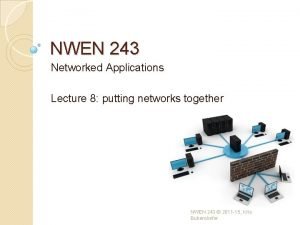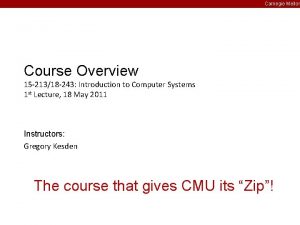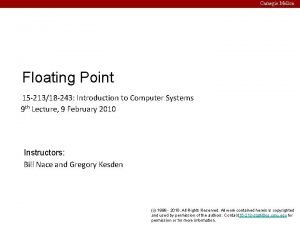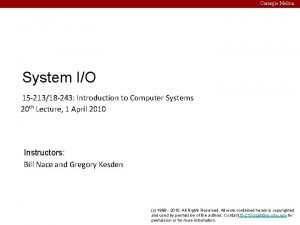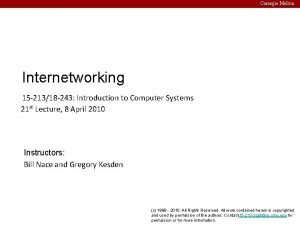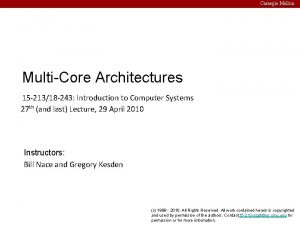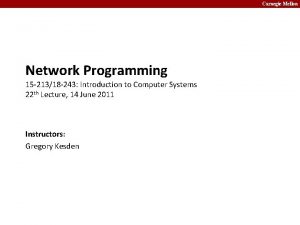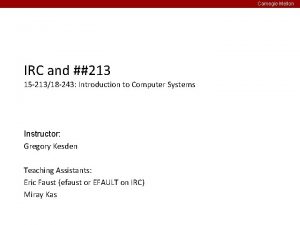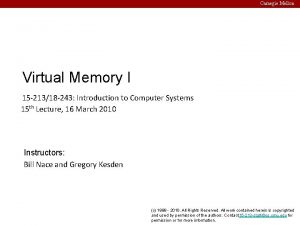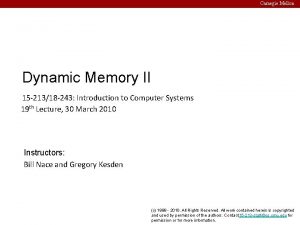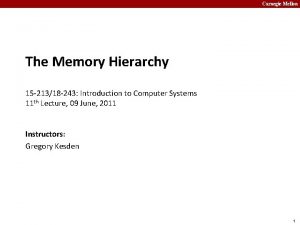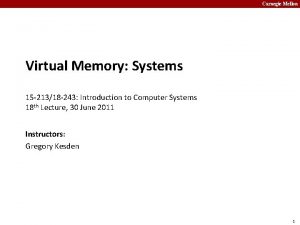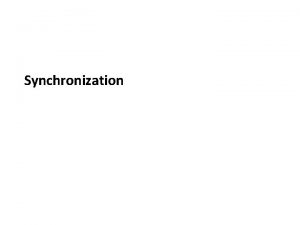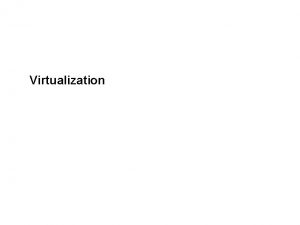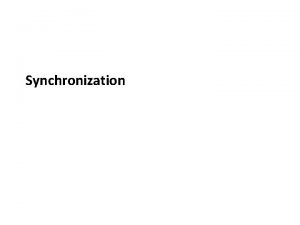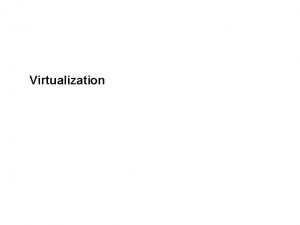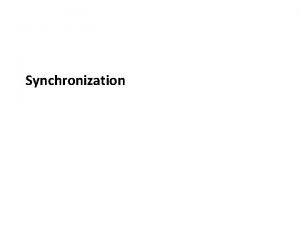Carnegie Mellon Course Overview 15 21318 243 Introduction












![Carnegie Mellon Memory Referencing Bug Example double fun(int i) { volatile double d[1] = Carnegie Mellon Memory Referencing Bug Example double fun(int i) { volatile double d[1] =](https://slidetodoc.com/presentation_image/f3d7c7bda24efde9b954be564e0ea760/image-13.jpg)
![Carnegie Mellon Memory Referencing Bug Example double fun(int i) { volatile double d[1] = Carnegie Mellon Memory Referencing Bug Example double fun(int i) { volatile double d[1] =](https://slidetodoc.com/presentation_image/f3d7c7bda24efde9b954be564e0ea760/image-14.jpg)

![Carnegie Mellon Memory System Performance Example void copyij(int src[2048], int dst[2048]) { int i, Carnegie Mellon Memory System Performance Example void copyij(int src[2048], int dst[2048]) { int i,](https://slidetodoc.com/presentation_image/f3d7c7bda24efde9b954be564e0ea760/image-16.jpg)





























- Slides: 45

Carnegie Mellon Course Overview 15 -213/18 -243: Introduction to Computer Systems 1 st Lecture, 11 January 2010 Instructors: Bill Nace and Gregory Kesden The course that gives CMU its “Zip”!

Carnegie Mellon Overview Course theme ¢ Five realities ¢ How the course fits into the CS/ECE curriculum ¢ Logistics ¢

Carnegie Mellon Course Theme: Abstraction Is Good But Don’t Forget Reality ¢ Most CS and CE courses emphasize abstraction § Abstract data types § Asymptotic analysis ¢ These abstractions have limits § Especially in the presence of bugs § Need to understand details of underlying implementations ¢ Useful outcomes § Become more effective programmers Able to find and eliminate bugs efficiently § Able to understand tune for program performance § Prepare for later “systems” classes in CS & ECE § Compilers, Operating Systems, Networks, Computer Architecture, Embedded Systems §

Great Reality #1: Ints are not Integers, Floats are not Reals 2 ¢ Example 1: Is x ≥ 0? Carnegie Mellon § Float’s: Yes! § Int’s: 40000 * 40000 ➙ 160000 § 50000 * 50000 ➙ ? ? § ¢ Example 2: Is (x + y) + z = x + (y + z)? § Unsigned & Signed Int’s: Yes! § Float’s: (1 e 20 + -1 e 20) + 3. 14 --> 3. 14 § 1 e 20 + (-1 e 20 + 3. 14) --> ? ? § xkcd. com/571

Carnegie Mellon Code Security Example /* Kernel memory region holding user-accessible data */ #define KSIZE 1024 char kbuf[KSIZE]; /* Copy at most maxlen bytes from kernel region to user buffer */ int copy_from_kernel(void *user_dest, int maxlen) { /* Byte count len is minimum of buffer size and maxlen */ int len = KSIZE < maxlen ? KSIZE : maxlen; memcpy(user_dest, kbuf, len); return len; } Similar to code found in Free. BSD’s implementation of getpeername ¢ There are legions of smart people trying to find vulnerabilities in programs ¢

Carnegie Mellon Typical Usage /* Kernel memory region holding user-accessible data */ #define KSIZE 1024 char kbuf[KSIZE]; /* Copy at most maxlen bytes from kernel region to user buffer */ int copy_from_kernel(void *user_dest, int maxlen) { /* Byte count len is minimum of buffer size and maxlen */ int len = KSIZE < maxlen ? KSIZE : maxlen; memcpy(user_dest, kbuf, len); return len; } #define MSIZE 528 void getstuff() { char mybuf[MSIZE]; copy_from_kernel(mybuf, MSIZE); printf(“%sn”, mybuf); }

Carnegie Mellon Malicious Usage /* Kernel memory region holding user-accessible data */ #define KSIZE 1024 char kbuf[KSIZE]; /* Copy at most maxlen bytes from kernel region to user buffer */ int copy_from_kernel(void *user_dest, int maxlen) { /* Byte count len is minimum of buffer size and maxlen */ int len = KSIZE < maxlen ? KSIZE : maxlen; memcpy(user_dest, kbuf, len); return len; } #define MSIZE 528 void getstuff() { char mybuf[MSIZE]; copy_from_kernel(mybuf, -MSIZE); . . . }

Carnegie Mellon Computer Arithmetic ¢ Does not generate random values § Arithmetic operations have important mathematical properties ¢ Cannot assume all “usual” mathematical properties § Due to finiteness of representations § Integer operations satisfy “ring” properties Commutativity, associativity, distributivity § Floating point operations satisfy “ordering” properties § Monotonicity, values of signs § ¢ Observation § Need to understand which abstractions apply in which contexts § Important issues for compiler writers and serious application programmers

Carnegie Mellon Great Reality #2: You’ve Got to Know Assembly ¢ Chances are, you’ll never write programs in assembly § Compilers are much better & more patient than you are ¢ But: Understanding assembly is key to machine-level execution model § Behavior of programs in presence of bugs High-level language models break down § Tuning program performance § Understand optimizations done / not done by the compiler § Understanding sources of program inefficiency § Implementing system software § Compiler has machine code as target § Operating systems must manage process state § Creating / fighting malware § x 86 assembly is the language of choice! §

Carnegie Mellon Assembly Code Example ¢ Time Stamp Counter § Special 64 -bit register in Intel-compatible machines § Incremented every clock cycle § Read with rdtsc instruction ¢ Application § Measure time (in clock cycles) required by procedure double t; start_counter(); P(); t = get_counter(); printf("P required %f clock cyclesn", t);

Carnegie Mellon Code to Read Counter Write small amount of assembly code using GCC’s asm facility ¢ Inserts assembly code into machine code generated by compiler ¢ static unsigned cyc_hi = 0; static unsigned cyc_lo = 0; /* Set *hi and *lo to the high and low order bits of the cycle counter. */ void access_counter(unsigned *hi, unsigned *lo) { asm("rdtsc; movl %%edx, %0; movl %%eax, %1" : "=r" (*hi), "=r" (*lo) : : "%edx", "%eax"); }

Great Reality #3: Memory Matters Carnegie Mellon Random Access Memory Is an Unphysical Abstraction ¢ Memory is not unbounded § It must be allocated and managed § Many applications are memory dominated ¢ Memory referencing bugs especially pernicious § Effects are distant in both time and space ¢ Memory performance is not uniform § Cache and virtual memory effects can greatly affect program performance § Adapting program to characteristics of memory system can lead to major speed improvements
![Carnegie Mellon Memory Referencing Bug Example double funint i volatile double d1 Carnegie Mellon Memory Referencing Bug Example double fun(int i) { volatile double d[1] =](https://slidetodoc.com/presentation_image/f3d7c7bda24efde9b954be564e0ea760/image-13.jpg)
Carnegie Mellon Memory Referencing Bug Example double fun(int i) { volatile double d[1] = {3. 14}; volatile long int a[2]; a[i] = 1073741824; /* Possibly out of bounds */ return d[0]; } fun(0) fun(1) fun(2) fun(3) fun(4) ➙ ➙ ➙ 3. 14 3. 1399998664856 2. 00000061035156 3. 14, then segmentation fault Result is architecture specific ¢ § I execute up to fun(11) on my Core 2 Duo Mac
![Carnegie Mellon Memory Referencing Bug Example double funint i volatile double d1 Carnegie Mellon Memory Referencing Bug Example double fun(int i) { volatile double d[1] =](https://slidetodoc.com/presentation_image/f3d7c7bda24efde9b954be564e0ea760/image-14.jpg)
Carnegie Mellon Memory Referencing Bug Example double fun(int i) { volatile double d[1] = {3. 14}; volatile long int a[2]; a[i] = 1073741824; /* Possibly out of bounds */ return d[0]; } fun(0) fun(1) fun(2) fun(3) fun(4) ➙ ➙ ➙ Explanation: 3. 14 3. 1399998664856 2. 00000061035156 3. 14, then segmentation fault Saved State 4 d 7. . . d 4 3 d 3. . . d 0 2 a[1] 1 a[0] 0 Location accessed by fun(i)

Carnegie Mellon Memory Referencing Errors ¢ C and C++ do not provide any memory protection § Out of bounds array references § Invalid pointer values § Abuses of malloc/free ¢ Can lead to nasty bugs § Whether or not bug has any effect depends on system and compiler § Action at a distance Corrupted object logically unrelated to one being accessed § Effect of bug may be first observed long after it is generated § ¢ How can I deal with this? § Program in Java, Ruby or ML § Understand what possible interactions may occur § Use or develop tools to detect referencing errors
![Carnegie Mellon Memory System Performance Example void copyijint src2048 int dst2048 int i Carnegie Mellon Memory System Performance Example void copyij(int src[2048], int dst[2048]) { int i,](https://slidetodoc.com/presentation_image/f3d7c7bda24efde9b954be564e0ea760/image-16.jpg)
Carnegie Mellon Memory System Performance Example void copyij(int src[2048], int dst[2048]) { int i, j; for (i = 0; i < 2048; i++) for (j = 0; j < 2048; j++) dst[i][j] = src[i][j]; } void copyji(int src[2048], int dst[2048]) { int i, j; for (j = 0; j < 2048; j++) for (i = 0; i < 2048; i++) dst[i][j] = src[i][j]; } 21 times slower (Pentium 4) Hierarchical memory organization ¢ Performance depends on access patterns ¢ § Including how step through multi-dimensional array

Carnegie Mellon The Memory Mountain Read throughput (MB/s) Pentium III Xeon 550 MHz 16 KB on-chip L 1 d-cache 16 KB on-chip L 1 i-cache 512 KB off-chip unified L 2 cache 1200 1000 L 1 800 600 400 L 2 32 k 128 k 512 k 2 m 8 m s 15 s 13 s 11 Stride (words) s 9 2 k Mem s 7 s 5 s 3 s 1 0 8 k 200 Working set size (bytes)

Carnegie Mellon Great Reality #4: There’s more to performance than asymptotic complexity Constant factors matter too! ¢ And even exact op count does not predict performance ¢ § Easily see 10: 1 performance range depending on how code written § Must optimize at multiple levels: algorithm, data representations, procedures, and loops ¢ Must understand system to optimize performance § How programs compiled and executed § How to measure program performance and identify bottlenecks § How to improve performance without destroying code modularity and generality

Carnegie Mellon Example Matrix Multiplication Matrix-Matrix Multiplication (MMM) on 2 x Core 2 Duo 3 GHz (double precision) Gflop/s Best code (K. Goto) 160 x Triple loop ¢ ¢ ¢ Standard desktop computer, vendor compiler, using optimization flags Both implementations have exactly the same operations count (2 n 3) What is going on?

Carnegie Mellon MMM Plot: Analysis Matrix-Matrix Multiplication (MMM) on 2 x Core 2 Duo 3 GHz Gflop/s Multiple threads: 4 x Vector instructions: 4 x Memory hierarchy and other optimizations: 20 x ¢ ¢ Reason for 20 x: Blocking or tiling, loop unrolling, array scalarization, instruction scheduling, search to find best choice Effect: less register spills, less L 1/L 2 cache misses, less TLB misses

Great Reality #5: Computers do more than execute programs ¢ They need to get data in and out § I/O system critical to program reliability and performance ¢ They communicate with each other over networks § Many system-level issues arise in presence of network Concurrent operations by autonomous processes § Coping with unreliable media § Cross platform compatibility § Complex performance issues § Carnegie Mellon

Carnegie Mellon Role within CS/ECE Curriculum ECE 545/549 Capstone CS 412 OS Practicum CS 415 Databases CS 441 Networks Data Reps. Memory Model CS 410 Operating Systems Network Protocols CS 411 Compilers ECE 340 Digital Computation Processes Machine Mem. Mgmt Code Arithmetic CS 213 ECE 243 CS 123 C Programming ECE 447 Architecture ECE 349 Embedded Systems ECE 348 Embedded System Eng. Execution Model Memory System Foundation of Computer Systems Underlying principles for hardware, software, and networking

Carnegie Mellon Course Perspective ¢ Most Systems Courses are Builder-Centric § Computer Architecture Design pipelined processor in Verilog § Operating Systems § Implement large portions of operating system § Compilers § Write compiler for simple language § Networking § Implement and simulate network protocols §

Carnegie Mellon Course Perspective (Cont. ) ¢ Our Course is Programmer-Centric § Purpose is to show by knowing more about the underlying system, one can be more effective as a programmer § Enable you to § Write programs that are more reliable and efficient § Incorporate features that require hooks into OS – E. g. , concurrency, signal handlers § Not just a course for dedicated hackers § We bring out the hidden hacker in everyone § Cover material in this course that you won’t see elsewhere

Carnegie Mellon Teaching staff We’re glad to talk with you, but please send email or phone first if (you_love(‘C’)){ honk( ); }

Carnegie Mellon Textbooks ¢ Randal E. Bryant and David R. O’Hallaron, § “Computer Systems: A Programmer’s Perspective”, Prentice Hall 2003 § http: //csapp. cs. cmu. edu § This book really matters for the course! How to solve labs § Practice problems typical of exam problems § ¢ Brian Kernighan and Dennis Ritchie, § “The C Programming Language, Second Edition”, Prentice Hall, 1988

Carnegie Mellon Course Components ¢ Lectures § Higher level concepts ¢ Recitations § Applied concepts, important tools and skills for labs, clarification of lectures, exam coverage ¢ Labs (6) § § ¢ The heart of the course 2 or 3 weeks each Provide in-depth understanding of an aspect of systems Programming and measurement Exams (2 + final) § Test your understanding of concepts & mathematical principles

Carnegie Mellon Getting Help ¢ Class Web Page § http: //www. cs. cmu. edu/~213 § Copies of lectures, assignments, exams, solutions § Clarifications to assignments ¢ Message Board § http: //autolab. cs. cmu. edu § Clarifications to assignments, general discussion § The only board your instructors will be monitoring (No Blackboard)

Carnegie Mellon Getting Help ¢ Staff mailing list § § ¢ 15 -213 -staff@cs. cmu. edu “The autolab server is down!” “Who should I talk to about. . . ” “This code {. . . }, which I don't want to post to the bboard, causes my computer to melt into slag. ” Teaching assistants § I don't get “associativity”. . . § Office hours, e-mail, by appointment § ¢ Please send mail to 15 -213 -staff, not a randomly-selected TA Professors § Office hours or appointment § “Should I drop the class? ” “A TA said. . . but. . . ”

Carnegie Mellon Getting Help: Office Hours Kesden: see course website ¢ Nace: Wednesdays, 2: 00 pm - 4: 30 pm ¢ ¢ TAs: § Sundays – Thursdays, 6: 00 pm – 9: 00 pm § Wean Hall 5207 cluster

Carnegie Mellon Policies: Assignments (Labs) And Exams ¢ Work groups § You must work alone unless told otherwise in writing ¢ Handins § Assignments due at 11: 59 pm on Tues or Thurs evening § Electronic handins using Autolab (no exceptions!) ¢ Conflict exams, other irreducible conflicts § OK, but must make PRIOR arrangements with Prof. Kesden / Nace § Notifying us well ahead of time shows maturity and makes us like you more (and thus to work harder to help you out of your problem) ¢ Appealing grades § Within 7 days of completion of grading Following procedure described in syllabus § Labs: Email to the staff mailing list § Exams: Talk to Prof. Kesden / Nace §

Carnegie Mellon Facilities ¢ Labs will use the Intel Computer Systems Cluster (aka “the fish machines”) § § § ¢ 15 Pentium Xeon servers donated by Intel for CS 213 Dual 3. 2 Ghz 64 -bit (EM 64 T) Nocona Xeon processors 2 GB, 400 MHz DDR 2 SDRAM memory Rack mounted in the 3 rd floor Wean Hall machine room Your accounts are ready or nearing readiness Getting help with the cluster machines: § See course Web page for login directions § Please direct questions to your TA’s first

Carnegie Mellon Timeliness ¢ Grace days § 4 for the course § Covers scheduling crunch, out-of-town trips, illnesses, minor setbacks § Save them until late in the term! ¢ Lateness penalties § Once grace days used up, get penalized 15% / day § Typically shut off all handins 2— 3 days after due date ¢ Catastrophic events § Major illness, death in family, … § Formulate a plan (with your academic advisor) to get back on track ¢ Advice § Once you start running late, it’s really hard to catch up

Carnegie Mellon Cheating ¢ What is cheating? § Sharing code: by copying, retyping, looking at, or supplying a file § Coaching: helping your friend to write a lab, line by line § Copying code from previous course or from elsewhere on WWW § ¢ Only allowed to use code we supply, or from CS: APP website What is NOT cheating? § Explaining how to use systems or tools § Helping others with high-level design issues ¢ Penalty for cheating: § Removal from course with failing grade § Permanent mark on your record ¢ Detection of cheating: § We do check § Our tools for doing this are much better than most cheaters think!

Carnegie Mellon Other Rules of the Lecture Hall ¢ Laptops: permitted ¢ Electronic communications: forbidden § No email, instant messaging, cell phone calls, etc ¢ Presence in lectures, recitations: voluntary, recommended

Carnegie Mellon Policies: Grading Exams: weighted ¼, ¼, ½ (final) ¢ Labs: weighted according to effort (determined near the end) ¢ ¢ The lower of lab score and exam score is weighted 60%, the higher 40%: § Lab score: 0 ≤ L ≤ 100, Exam score: 0 ≤ E ≤ 100 Total score: 0. 6 min(L, E) + 0. 4 max(L, E) ¢ Guaranteed: § > 90%: A § > 80%: B § > 70%: C

Carnegie Mellon Programs and Data ¢ Topics § Bits operations, arithmetic, assembly language programs § Representation of C control and data structures § Includes aspects of architecture and compilers ¢ Assignments § L 1 (datalab): Manipulating bits § L 2 (bomblab): Defusing a binary bomb § L 3 (buflab): Hacking a buffer bomb

Carnegie Mellon The Memory Hierarchy ¢ Topics § Memory technology, memory hierarchy, caches, disks, locality § Includes aspects of architecture and OS

Carnegie Mellon Performance ¢ Topics § Co-optimization (control and data), measuring time on a computer § Includes aspects of architecture, compilers, and OS

Carnegie Mellon Exceptional Control Flow ¢ Topics § Hardware exceptions, processes, process control, Unix signals, nonlocal jumps § Includes aspects of compilers, OS, and architecture ¢ Assignments § L 4 (tshlab): Writing your own shell with job control

Carnegie Mellon Virtual Memory ¢ Topics § Virtual memory, address translation, dynamic storage allocation § Includes aspects of architecture and OS ¢ Assignments § L 5 (malloclab): Writing your own malloc package § Get a real feel for systems programming

Carnegie Mellon Networking, and Concurrency ¢ Topics § § § ¢ High level and low-level I/O, network programming Internet services, Web servers concurrency, concurrent server design, threads I/O multiplexing with select Includes aspects of networking, OS, and architecture Assignments § L 6 (proxylab): Writing your own Web proxy

Carnegie Mellon Lab Rationale ¢ Each lab has a well-defined goal such as solving a puzzle or winning a contest ¢ Doing the lab should result in new skills and concepts ¢ We try to use competition in a fun and healthy way § Set a reasonable threshold for full credit § Post intermediate results (anonymized) on Web page for glory!

Carnegie Mellon Autolab Web Service ¢ Labs are provided by the Autolab system § Autograding handin system developed in 2003 by Dave O’Hallaron § Apache Web server + Perl CGI programs § Beta tested Fall 2003, very stable by now ¢ With Autolab you can use your Web browser to: § § § Review lab notes, clarifications Download the lab materials Stream autoresults to a class status Web page as you work Handin your code for autograding by the Autolab server View the complete history of your code handins, autoresult submissions, autograding reports, and instructor evaluations § View the class status page

Carnegie Mellon Have Fun!
 Cmu comp bio
Cmu comp bio Carnegie mellon interdisciplinary
Carnegie mellon interdisciplinary Carnegie mellon software architecture
Carnegie mellon software architecture Cmu bomb threat
Cmu bomb threat Carnegie mellon software architecture
Carnegie mellon software architecture Citi training cmu
Citi training cmu Cmu mism
Cmu mism Randy pausch time management
Randy pausch time management Carnegie mellon what is rpa robotic process automation
Carnegie mellon what is rpa robotic process automation Carnegie mellon
Carnegie mellon 18-213 cmu
18-213 cmu Cmu vpn
Cmu vpn Carnegie mellon
Carnegie mellon Carnegie mellon
Carnegie mellon Carnegie mellon
Carnegie mellon Frax
Frax Carnegie mellon fat letter
Carnegie mellon fat letter Carnegie mellon
Carnegie mellon Carnegie mellon
Carnegie mellon Mellon serbia iskustva
Mellon serbia iskustva Carneigh mellon
Carneigh mellon Christina mellon
Christina mellon Wageworks health equity
Wageworks health equity Zebulun krahn
Zebulun krahn Water mellon
Water mellon Mellon elf
Mellon elf Mellon elf
Mellon elf Mellon elf
Mellon elf Il viaggio di telemaco
Il viaggio di telemaco Write the expression 53 125 in logarithmic form
Write the expression 53 125 in logarithmic form Cechy kodu genetycznego prezentacja
Cechy kodu genetycznego prezentacja Article 243 x
Article 243 x 243 p
243 p Art. 243 kpk
Art. 243 kpk Cs 243
Cs 243 Vibs histology
Vibs histology ³log 243=p
³log 243=p Przedszkole nr 243
Przedszkole nr 243 Przedszkole nr 243
Przedszkole nr 243 Jika log 2 = 0 301 dan log 3 = 0 778 nilai log 36 adalah
Jika log 2 = 0 301 dan log 3 = 0 778 nilai log 36 adalah Cuneiform tablet
Cuneiform tablet Connective tissue
Connective tissue Jika log 2= 0 301 nilai log 0 16 adalah
Jika log 2= 0 301 nilai log 0 16 adalah Nwen243
Nwen243 Jarak rata rata antara mars dan matahari adalah 1 524 kali
Jarak rata rata antara mars dan matahari adalah 1 524 kali Misalkan an adalah barisan geometri
Misalkan an adalah barisan geometri

